By: 4R Plus
August 2019

Eric Andersen is the third generation to care for the fertile farmland in Grundy County. He and his wife Darla farm commercial and seed corn and soybeans and are focused on using 4R Plus practices, like waterways, no-till and cover crops, to protect their valuable investment so future generations can make a living on the land.
Twenty years ago he started planting cover crops after seed corn harvest to protect the soil. “I noticed one of the fields was in bad shape after harvest and I knew something needed to be done,” he said. “That first year I planted oats as a cover crop and they were 3 feet tall before winterkill.”
Andersen believes cover crops are a perfect fit for seed corn acres because they provide time for good establishment in the fall and keep active roots in the soil longer. “I knew it wasn’t right to leave the ground bare. Now I plant rye to get the growth and biological activity benefits in the fall and spring,” he said.
Andersen’s not concerned about putting a dollar amount on the cost of using cover crops because he’s most interested in protecting the highly valuable land he farms. “Farmers spend money on all kinds of things that are hard to justify and don’t necessarily cash flow,” he explained. “We made the decision years ago to invest in the soil that we’re making a living on.
“I’m interested in maintaining the land so it’s more productive next year and the year after that,” he added. “We need to focus on improving our practices for the betterment of the land.”

Over the years, the Andersen’s have had several opportunities to expand their operation when opportunity came looking for them. Landowners in the area have come to him interested in him farming their land because they felt comfortable with him taking care of their land and their family’s investment.
Now Andersen works with eight different landowners. “I’m not interested in bidding land away from other farmers. I have found my niche as a farmer in the area that will do what is right for the land,” he said.
Maintaining those relationships is not difficult for Andersen, who understands why some landowners want regular updates. “I meet with everyone individually in December and keep in contact throughout the year about the challenges and successes we’re having on the farm because each year is different,” he said. “I know there could be a lot of change coming in the future as some of the land I rent transitions through estates, but in the meantime, that’s not going to change how I manage their land.”
With an attitude to continually improve the way he farms, Andersen said he’s open minded about adding a bioreactor in the future and expanding cover crops as much as possible. This fall he’s changing the soil sampling program. “As soil health testing expands and improves, I want to have a foundation to compare and track progress,” he said. “I want to more closely assess and build soil health and nutrients.”
“I encourage farmers to investigate the 4R Plus tools that are available,” he said. “Check out the cost-share programs that are available and make your mind up that protecting the soil is the right thing for the future of your farm.”



